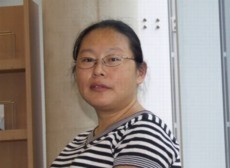Home > Press > Green feel for collaboration with China
 |
| Dr Li Li has received a Queensland International Fellowship. |
Abstract:
Dr Li Li is building a bridge between researchers in Australia and China as she works to reduce car emissions using high-performance nano-engineering.
Green feel for collaboration with China
Brisbane, Australia | Posted on June 28th, 2012
The materials scientist from UQ's Australian Institute for Bioengineering and Nanotechnology (AIBN) is working with experts from the Chinese Academy of Sciences to reduce emissions of volatile organic compounds (VOCs).
Dr Li has received a Queensland International Fellowship to help her travel to China and work with Research Center for Eco-Environmental Science Professor Zhengping Hao.
The fellowship, worth $16,000, will cement a collaboration between AIBN, based at The University of Queensland, and the Chinese academy involving the development of high-performance catalysts for VOC removal, using a catalytic oxidation process.
Dr Li said a desire to help improve air quality motivated her in her research with AIBN supervisors, Professor Chengzhong (Michael) Yu and Associate Professor Zhiping (Gordon) Xu.
"VOC emissions greatly affect air quality in our cities. Each year in Australia more than 60,000 tonnes of VOCs are released into the atmosphere," she said.
"They are very toxic to human health and cause severe environmental problems through the formation of photochemical smog.
"This is what attracted me to this area of research and motivates me to try to develop a cheaper catalyst to eliminate VOCs to improve air quality."
Dr Li said VOCs were carbon-based chemicals that easily evaporated into gaseous forms at room temperature.
The collaboration with Professor Hao aimed to develop a high-performance and cost-effective metal oxide catalysts for VOC elimination.
"Prof Hao's group has successfully developed a number of VOC catalysts, which have been applied in some industries for VOC removal to control the emission of organic pollutants.
"Through this collaboration we expect to build on this to develop a promising technique and advanced nanomaterials to reduce VOC emissions in vehicles - to further improve air quality.
"I expect to establish a long-term collaborative research alliance between Australia and China in the field of environmental pollution control and protection.
"This will advance my skills and knowledge on nanocatalytic systems for environmental pollution control and remediation."
Dr Li's work at AIBN spans several areas, including the development of silica- and carbon-based nanomaterials for clean energy production and waste water treatment and nanoparticles for drug and gene delivery.
####
For more information, please click here
Contacts:
Erik de Wit
0427 281 466, 3346 3962
Copyright © University of Queensland
If you have a comment, please Contact us.Issuers of news releases, not 7th Wave, Inc. or Nanotechnology Now, are solely responsible for the accuracy of the content.
| Related News Press |
News and information
![]() Simulating magnetization in a Heisenberg quantum spin chain April 5th, 2024
Simulating magnetization in a Heisenberg quantum spin chain April 5th, 2024
![]() NRL charters Navy’s quantum inertial navigation path to reduce drift April 5th, 2024
NRL charters Navy’s quantum inertial navigation path to reduce drift April 5th, 2024
![]() Discovery points path to flash-like memory for storing qubits: Rice find could hasten development of nonvolatile quantum memory April 5th, 2024
Discovery points path to flash-like memory for storing qubits: Rice find could hasten development of nonvolatile quantum memory April 5th, 2024
Academic/Education
![]() Rice University launches Rice Synthetic Biology Institute to improve lives January 12th, 2024
Rice University launches Rice Synthetic Biology Institute to improve lives January 12th, 2024
![]() Multi-institution, $4.6 million NSF grant to fund nanotechnology training September 9th, 2022
Multi-institution, $4.6 million NSF grant to fund nanotechnology training September 9th, 2022
Nanomedicine
![]() New micromaterial releases nanoparticles that selectively destroy cancer cells April 5th, 2024
New micromaterial releases nanoparticles that selectively destroy cancer cells April 5th, 2024
![]() Good as gold - improving infectious disease testing with gold nanoparticles April 5th, 2024
Good as gold - improving infectious disease testing with gold nanoparticles April 5th, 2024
![]() Researchers develop artificial building blocks of life March 8th, 2024
Researchers develop artificial building blocks of life March 8th, 2024
Announcements
![]() NRL charters Navy’s quantum inertial navigation path to reduce drift April 5th, 2024
NRL charters Navy’s quantum inertial navigation path to reduce drift April 5th, 2024
![]() Discovery points path to flash-like memory for storing qubits: Rice find could hasten development of nonvolatile quantum memory April 5th, 2024
Discovery points path to flash-like memory for storing qubits: Rice find could hasten development of nonvolatile quantum memory April 5th, 2024
Environment
![]() Billions of nanoplastics released when microwaving baby food containers: Exposure to plastic particles kills up to 75% of cultured kidney cells July 21st, 2023
Billions of nanoplastics released when microwaving baby food containers: Exposure to plastic particles kills up to 75% of cultured kidney cells July 21st, 2023
Water
![]() Taking salt out of the water equation October 7th, 2022
Taking salt out of the water equation October 7th, 2022
Automotive/Transportation
![]() Researchers’ approach may protect quantum computers from attacks March 8th, 2024
Researchers’ approach may protect quantum computers from attacks March 8th, 2024
![]() Tests find no free-standing nanotubes released from tire tread wear September 8th, 2023
Tests find no free-standing nanotubes released from tire tread wear September 8th, 2023
|
|
||
|
|
||
| The latest news from around the world, FREE | ||
|
|
||
|
|
||
| Premium Products | ||
|
|
||
|
Only the news you want to read!
Learn More |
||
|
|
||
|
Full-service, expert consulting
Learn More |
||
|
|
||








